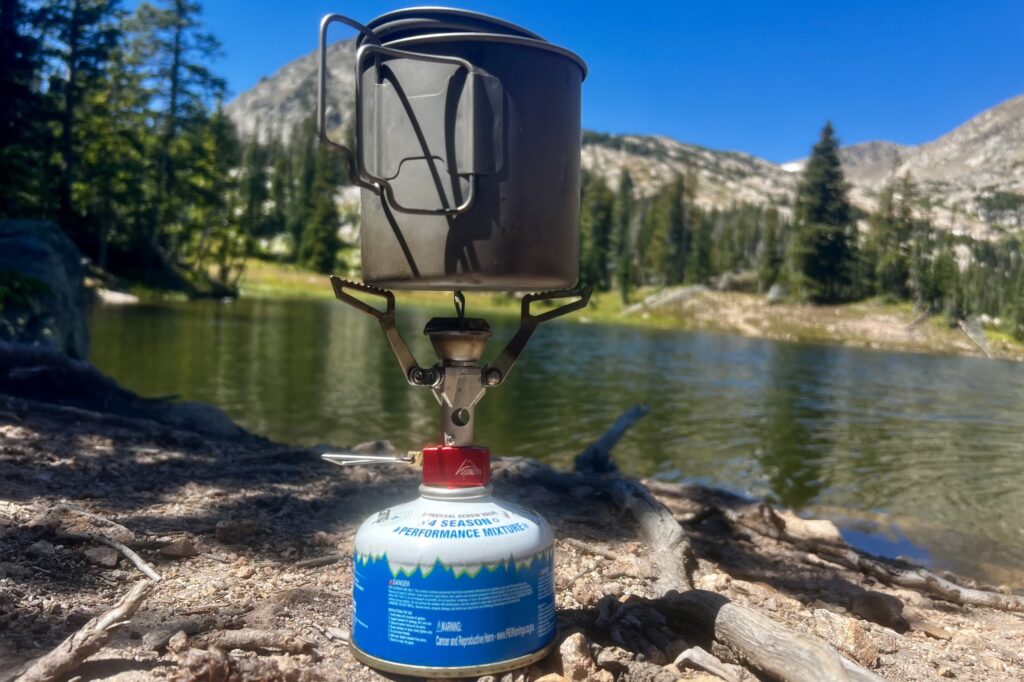
Bottom Line
We’re big fans of the SOTO WindMaster, and we highly recommend it to hikers who are over struggling against the wind to get a quick boil. Though it’s a bit on the expensive side for a canister stove, we think the WindMaster is worth every penny for its durability, stable pot supports, and efficiency. It’s one of our go-to stoves for exposed, windy areas and for hikes where we’re sharing a cookset with a partner. We’ve been whipping up delicious backcountry meals over hundreds of trail miles with this stove, and it’s one of our all-time favorites.
See how the WindMaster compares to our other favorites on our list of the best backpacking stoves.
Quick Specs

SOTO WindMaster
Efficient Stove with Excellent Wind Performance
CleverHiker Rating: 4.7/5.0
Price: $70
Weight: 3.1 oz.
Fuel Type: Isobutane/propane canister
Boil Time: 3m 5s
Burn Time (8 oz. fuel): 70m
Pros
- Performs well in wind
- Lightweight
- Efficient
- Push-button igniter
- Stable pot support
- Simmer control
Cons
- Slightly bulkier than some
- Expensive

Convenience
The WindMaster comes with a couple of unique features that add to its stability and ease of use. One of our favorites is the ability to swap between the sturdy 4Flex Support (included with the WindMaster) and the ultralight TriFlex Support (sold separately). The strong and stable 4Flex Pot Support allows you to use larger pots with the WindMaster, while the TriFlex Support saves weight and is more compact.
We typically prefer to take the 4Flex Support since it adds a lot of stability for a very small amount of weight over the TriFlex (perfect for couples who prefer to share a single large pot for boiling water). But hikers who are counting every gram and use a smaller pot may prefer the 0.7-ounce weight savings of the TriFlex. Both supports are a little finicky to install, but quick once you get used to them.
This is a somewhat small perk since we often find that the push-button igniter is the first thing to fail on stoves. But it’s a convenient feature – especially in windy areas where it can be difficult to use a lighter.
As we mentioned above, though, the WindMaster is very well-made. After 500+ miles of consistent use, the igniter still works beautifully and generally ignites on the first or second push. Either way, we always bring a mini Bic as a backup fire source – even if our stove has a push button.

Weight & Packability
With the included 4Flex Pot Support, the WindMaster weighs only 3.1 ounces. And hikers who were previously carrying a windscreen with a different stove can save some weight by ditching it for the superior wind performance of the WindMaster.
Compared to other stoves on our list, this one is in the middle of the pack for weight. That said, the top-tier models range from 1 ounce to 2.9 ounces – not a dramatic difference. Hikers who are looking to shave every bit of weight and bulk without sacrificing the great wind performance can save around 20 grams (0.7 ounces) by getting the TriFlex Pot Support.

Power & Efficiency
In our testing, the WindMaster was able to boil one liter of water in about three minutes, which is fast even for integrated stove systems. Adding a moderate amount of wind made a minimal effect on boil time due to the WindMaster’s recessed burner and full collar.
It is a bit on the pricier side, but we think it’s worth the cost for hikers who are often out in windy areas – above treeline, in open deserts, or in coastal regions – since it will boil a lot more efficiently than many of the other top stoves. We were able to get a full liter of water to boil in just over three minutes while only using 0.3 ounces of fuel. And when you take into account that the boil time only increased by about 50% when constant wind was introduced, that’s a level of efficiency that goes a long way.

Precision
The WindMaster allows for a good range of control over your flame, so you can boil quickly or simmer slowly for the perfect backcountry meal. Because the burner is so windproof, you can be confident that your flame won’t go out even on its lowest setting.
One thing to keep in mind is that, since your pot sits closer to the flame on the WindMaster than it does on many other canister stoves, you should keep a closer eye on the contents of your pot while you’re cooking/boiling. The more concentrated flame can overheat any food at the bottom of your pot a little more quickly than other stoves.

Should You Buy the SOTO WindMaster?
All in all, the WindMaster definitely lives up to its name. It makes the most sense for ultralight desert hikers, high alpine ridge campers, and anyone who is concerned about wind having an effect on cooking. It’s a hard stove to beat without switching to a much heavier, fully integrated stove system. The WindMaster is able to compete with the most windproof stoves while adding mere grams to its weight. It enhances its ease of use and versatility with added features like multiple pot supports and an igniter switch.
We think the SOTO WindMaster falls right in that sweet spot between size and performance, but for folks who heavily prioritize one over the other, there are better options. If performance is your main concern, integrated stoves like the MSR WindBurner offer peak performance albeit being significantly heavier.

What Other Backpacking Stoves Should You Consider?
MSR PocketRocket 2 Review: Though it isn’t as powerful or efficient, the MSR PocketRocket 2 offers additional simmer control, weight savings, and reliability.
MSR WindBurner Review: If the WindMaster’s performance in wind caught your eye, the MSR Windburner takes it to the next level. Although it’s definitely not light, it performed the best in the wind out of all of the canister stoves that we tested. It’s also quite stable.
Primus Essential Trail Review: The price tag of the WindMaster is probably a bit high for the beginner backpacker, but the Primus Essential Trail offers similar benefits for less than half the cost. For the price, it impressed us with its fuel efficiency, how well it did in the wind, and its stability. It also couldn’t be easier to use.















